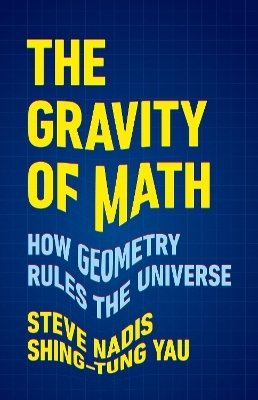
The gravity of math
how geometry rules the universe
Seiten
2024
|
1. Auflage
Basic Books (Verlag)
978-1-5416-0429-2 (ISBN)
Basic Books (Verlag)
978-1-5416-0429-2 (ISBN)
One of the preeminent mathematicians of the past half century shows how physics and math were combined to give us the theory of gravity and the dizzying array of ideas and insights that has come from it
Mathematics is far more than just the language of science. It is a critical underpinning of nature. The famed physicist Albert Einstein demonstrated this in 1915 when he showed that gravity-long considered an attractive force between massive objects-was actually a manifestation of the curvature, or geometry, of space and time. But in making this towering intellectual leap, Einstein needed the help of several mathematicians, including Marcel Grossmann, who introduced him to the geometrical framework upon which his theory rests.
In The Gravity of Math, Steve Nadis and Shing-Tung Yau consider how math can drive and sometimes even anticipate discoveries in physics. Examining phenomena like black holes, gravitational waves, and the Big Bang, Nadis and Yau ask: Why do mathematical statements, derived solely from logic, provide the best descriptions of our physical world?
The Gravity of Math offers an insightful and compelling look into the power of mathematics-whose reach, like that of gravity, can extend to the edge of the universe.
Mathematics is far more than just the language of science. It is a critical underpinning of nature. The famed physicist Albert Einstein demonstrated this in 1915 when he showed that gravity-long considered an attractive force between massive objects-was actually a manifestation of the curvature, or geometry, of space and time. But in making this towering intellectual leap, Einstein needed the help of several mathematicians, including Marcel Grossmann, who introduced him to the geometrical framework upon which his theory rests.
In The Gravity of Math, Steve Nadis and Shing-Tung Yau consider how math can drive and sometimes even anticipate discoveries in physics. Examining phenomena like black holes, gravitational waves, and the Big Bang, Nadis and Yau ask: Why do mathematical statements, derived solely from logic, provide the best descriptions of our physical world?
The Gravity of Math offers an insightful and compelling look into the power of mathematics-whose reach, like that of gravity, can extend to the edge of the universe.
Steve Nadis, a contributing editor to Discover magazine and a contributing writer to Quanta, lives in Cambridge, Massachusetts. Shing-Tung Yau is a mathematics professor at Tsinghua University and professor emeritus at Harvard University. The recipient of the Fields Medal, National Medal of Science, and a MacArthur Fellowship, he lives in Beijing. This is the fifth book that Nadis and Yau have written together.
| Erscheinungsdatum | 02.04.2024 |
|---|---|
| Zusatzinfo | Illustrationen |
| Verlagsort | New York |
| Sprache | englisch |
| Maße | 140 x 210 mm |
| Gewicht | 380 g |
| Einbandart | gebunden |
| Themenwelt | Mathematik / Informatik ► Mathematik ► Geometrie / Topologie |
| Naturwissenschaften ► Physik / Astronomie ► Relativitätstheorie | |
| ISBN-10 | 1-5416-0429-6 / 1541604296 |
| ISBN-13 | 978-1-5416-0429-2 / 9781541604292 |
| Zustand | Neuware |
| Informationen gemäß Produktsicherheitsverordnung (GPSR) | |
| Haben Sie eine Frage zum Produkt? |
Mehr entdecken
aus dem Bereich
aus dem Bereich
Gekrümmte Kurven und Flächen
Buch | Softcover (2024)
De Gruyter (Verlag)
CHF 76,90
Anwendungen in Natur und Technik
Buch | Softcover (2021)
Springer Berlin (Verlag)
CHF 53,15


